- Home
- After Effects
- Discussions
- Re: Wiggle transform effects all objects not group...
- Re: Wiggle transform effects all objects not group...
Copy link to clipboard
Copied
I am trying to have molecules vibrate so I am using the wiggle transform. So I am using H2O so I have three circles for each molecule. However, the wiggle transform is affecting each individual circle now each individual molecule. At first, it wasn't a problem it just looked slightly weird but now it is because I am having them vibrate a larger and I am increasing the "position" value in "Wiggle transform 1" > "Transform." I would appreciate if someone could help me with this.
Here is a image just to show what it currently looks like.

This is a school project and its due soon so if someone could answer soon that would be great. XD
 1 Correct answer
1 Correct answer
However, the wiggle transform is affecting each individual circle now each individual molecule.
you can't have it any other way using the wiggle transform operator. it will always affect all the shape groups it has above it. if you drag it into one shape group it will move only that shape group but if that group has more than one shape group inside it, it will move both. so you can't have your way with this operator because you can't really merge the molecule to include all three shapes as one s
...Copy link to clipboard
Copied
Is part of your school project to keep everything on a single layer?
If so then group paths and apply the wiggle to the groups transform.
If not then just make one wiggling molecule and duplicate the entire layer rather than trying have everything on one layer.
When you have all your molecules on a single shape layer and you're applying the wiggle to that shape layers position.
What do you expect is going to happen?
The solution is pretty obvious. Separate layers or work on group transforms rather than layer transforms.
Copy link to clipboard
Copied
You have all of your molecules in a group and only one wiggle expression so they will all wiggle as one. Each shape should have its own shape transform. You will need to add a different wiggle to each one of them. You can either use different values for each molecule or let random take over. There will probably be more visible differences if you enter different values.
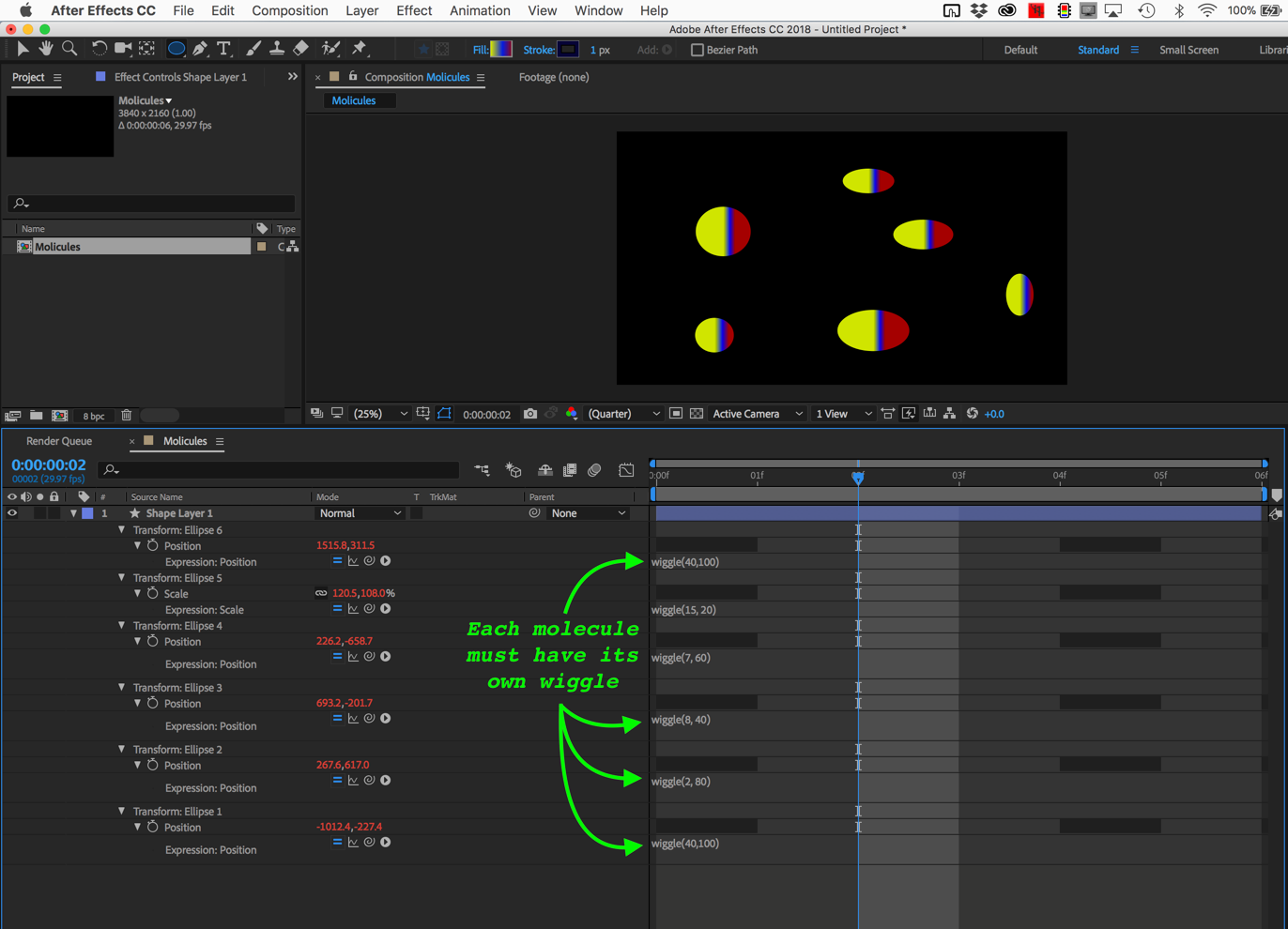
This is really basic stuff. Think about it for a moment. What would you expect to happen if you group a bunch of objects together and then move the group?
It is a lot easier to diagnose problems if you reveal all modified properties of the layer that is giving you problems. Do that by pressing the U key twice. I am pretty sure that I guessed correctly when I surmised that you have grouped a bunch of ellipses together in a single shape layer and applied the wiggle expression to the group transform.
Copy link to clipboard
Copied
You have to take into account the difference between a shape layer and a shape path. You have all your paths in shape layer so, like I said you would have to put the wiggle on each paths transform rather than the entire shape.
You still have not showed how you have your paths set up withing the layer so.....
Also the wiggle expression is random so duplicating the layer will not make them all wiggle the same, every instance of the wiggle expression will produce unique results.
Finally if you need to animate the amount of the wiggle you do that with an expression slider.
I made a video running through a few different option.
Let me know if you have any questions.
First I set up a separate wiggle for each path & duplicate. Then I set up a single wiggle for the entire shape & duplicate.
Then I add a slider multiplier & duplicate. The slider multiplier can also be added to the individual path expressions from the first example.
Copy link to clipboard
Copied
Two more option I didn't show is that you can have a separate slider (multiplier) control for each the freq & amp of the wiggle.
Also you can have a global control by creating the slider effect on a separate solid layer (visibility turned off) and connect the expression to that. Then everytime you duplicate the shape layer the new layer's expression will automatically be connected to that one controller.
And you'll still get a slightly random wiggle on every layer but they'll all increase or decrease at the same rate when you adjust the slider.
Copy link to clipboard
Copied
Thank you, this is very helpful... however... I am using the wiggle transform not inside the transform of the position but the from the "Add" button when you click a layer. I am using this because I find it easy to adjust and easy to understand since I'm new to this.
Here is what I mean:
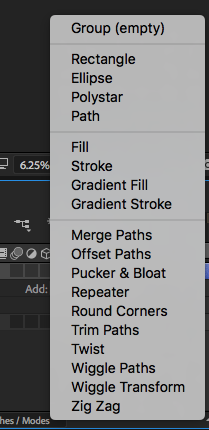
Copy link to clipboard
Copied
You are still adding the wiggle to the group. You need to reorganize your shape layer. I don't have time to give you another screenshot but itis all in the layer organization. Mke sure you pay attention to the indents.
Copy link to clipboard
Copied
I don't know how to organize it though. I am adding one wiggle transform and its write beneath the group that has all the molecules. I have a little too many groups within groups but this is what it looks like.
In my contents:

In my molecules is a bunch of molecules. 13 to be exact:

And each molecule has the Oxygen hydrogen and second hydrogen with their respective path, stroke, fill, and transform:

Copy link to clipboard
Copied
I see. Unfortunately despite the fact that teachers love it when students do it, taking the easy route often limits your options.
It seems that this is just how that operator functions, on every path above it in the stack (that's how all those operators work).
The only workaround I know of is to ad a merge paths operator above the wiggle transforms operator but this will affect the look.
If you add a merge paths beneath every three paths (every molecule) & then a wiggle transforms you'll have control over
every molecule but like I said will sacrifice the look. If there is another, easier way to do it I don't know about it.

By far the easiest option is to take few minutes to set up a single molecule with a manually created wiggle expression
and an expression control slider effect, which is essentially a multiplier, and then duplicate it.
Maybe you'll get extra credit. ![]()
Copy link to clipboard
Copied
However, the wiggle transform is affecting each individual circle now each individual molecule.
you can't have it any other way using the wiggle transform operator. it will always affect all the shape groups it has above it. if you drag it into one shape group it will move only that shape group but if that group has more than one shape group inside it, it will move both. so you can't have your way with this operator because you can't really merge the molecule to include all three shapes as one shape.
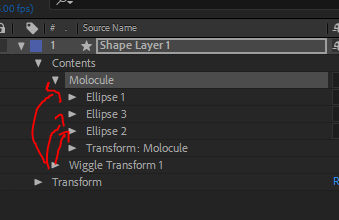
so the wiggle transform can affect all three as separate elements in one instance or affect each group only if you drag it inside. if that group has more group it will affect all of them. that's how it works.
so wiggle transform is a NO NO - got it?
so like Paul and Rick suggested, you could use expressions.
to make it easier on you, there is an option to use already made preset you have in the effects and preset panel called "wiggle-position". it's the same expression Paul and Rick suggested but it's already setup in a rig that is connected to sliders in the effects control panel. you would need each molecule to be on a separate layer. and add the wiggle-position preset from the effects and presets panel by typing its name and clicking on it twice while your layer is selected. like this:
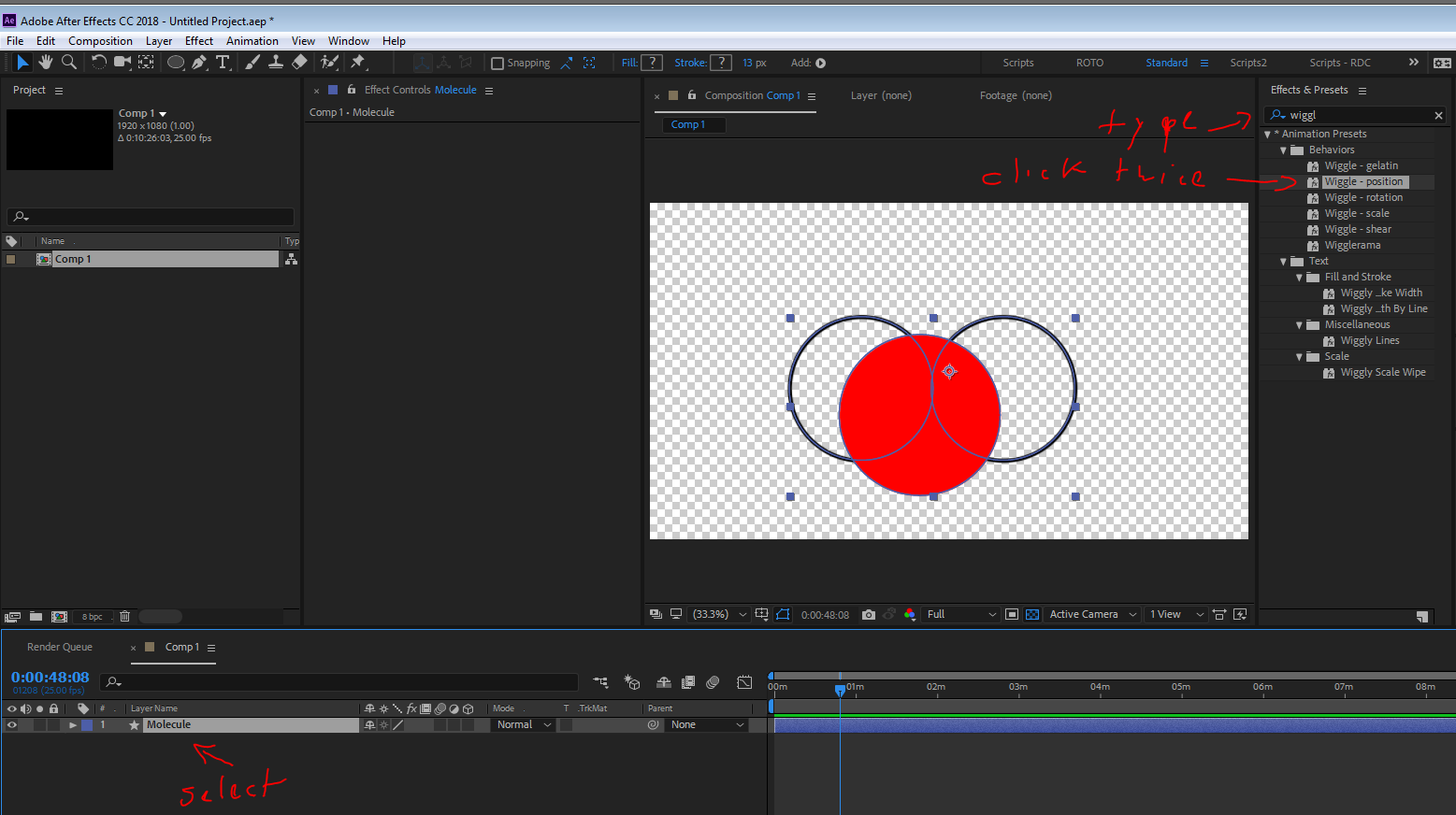
now you got these controls in the effects controls panel. you only need to play with the ones under "wiggle-position"

when you are satisfied, simply duplicate the layer, it will automatically look a bit different each time since wiggle is based on a random seed which is connected to the layer index number and the overall total of layers.

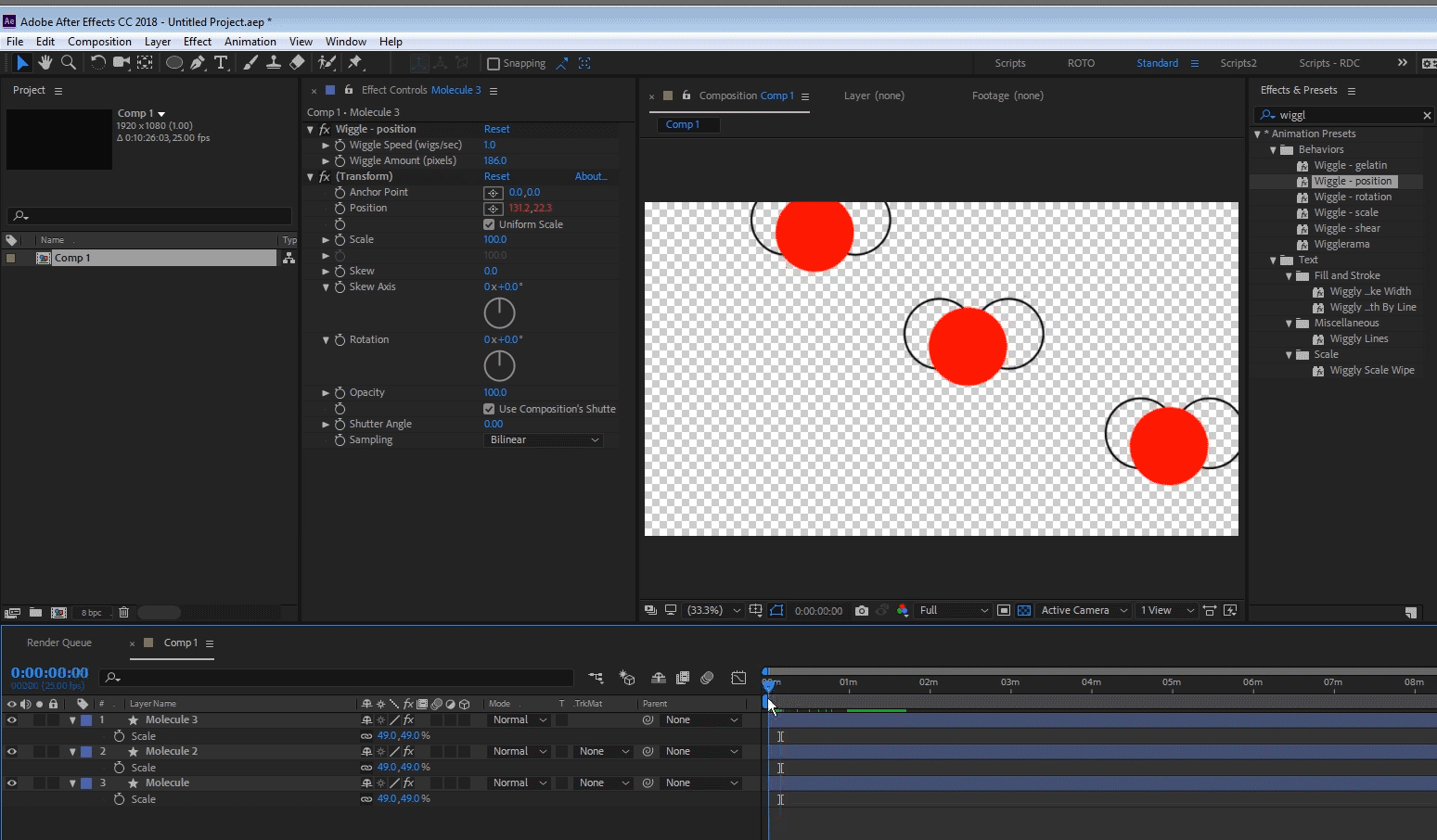
Copy link to clipboard
Copied
Thank you very much. I was hoping that I would be able to use the wiggle transform operator, however, if it doesn't do what I want it to do then I guess I will have to use the other one. Thank you again.
Copy link to clipboard
Copied
Make a null for a parent. Parent all the shape layers to that layer. Wiggle the null.
Copy link to clipboard
Copied
Make a null for a parent. Parent all the shape layers to that layer. Wiggle the null.
this will create the same wiggle for all the shapes as if all the shapes are moving as one layer. only if you create a wiggle expression for the position and all the layers as one layer (the preset won't work on this layer since it's a null and a null is always opacity 0% so effects don't work.)
Copy link to clipboard
Copied
The Wiggle Transform Shape Operator works by wiggling each Shape Path INDEPENDENTLY. The main premise is to allow you to create flocking scenes.
If you want to wiggle multiple Shape Paths as a single/group object, then you apply a Wiggle Expression. You do this by grouping the different Shape Paths. Then apply a Wiggle Expression to the Group's Transform>Position property - or any other Group>Transform property that suits your needs.
Try this Expression to wiggle both the X and Y position parameters independently -
wigME = wiggle(1,50);
[wigME[0],wigME[1]]
And use this Expression to wiggle just the X position parameter
wigME = wiggle(1,50);
[wigME[0],value[1]]
And use this Expression to wiggle just the Y position parameter
wigME = wiggle(1,50);
[value[0],wigME[1]]
Take note that wiggle(n1,n2) should be read as n1= number of wiggles per second and n2 is read as maximum deviation based on a +- of the stated number.
Copy link to clipboard
Copied
https://forums.adobe.com/people/Roei+Tzoref wrote
Make a null for a parent. Parent all the shape layers to that layer. Wiggle the null.this will create the same wiggle for all the shapes as if all the shapes are moving as one layer. only if you create a wiggle expression for the position and all the layers as one layer (the preset won't work on this layer since it's a null and a null is always opacity 0% so effects don't work.)
Isn't that what he wants? He wants each molecule to wiggle as a group of circles.
"I am trying to have molecules vibrate so I am using the wiggle transform. So I am using H2O so I have three circles for each molecule. However, the wiggle transform is affecting each individual circle now each individual molecule."
Copy link to clipboard
Copied
sjlocke215 wrote
Isn't that what he wants?
Apparently not. There were quite a few posts after the sentence you read and quoted.
Sometimes it helps to read past the first sentence of a thread.
Anyway "he" or she got the answer they were looking for so....
Copy link to clipboard
Copied
Roei's solution will definitely work but I believe it'll require three Shape Layers, with or without a Group.
My solution will require ONE Shape layer with three groups; where each Group's Transform>Position will have the wiggle Expression applied.
Copy link to clipboard
Copied
Suddenly this thread is beginning to make my stomach turn. ![]()
Find more inspiration, events, and resources on the new Adobe Community
Explore Now